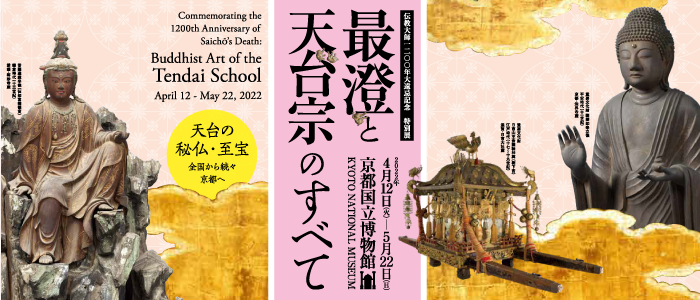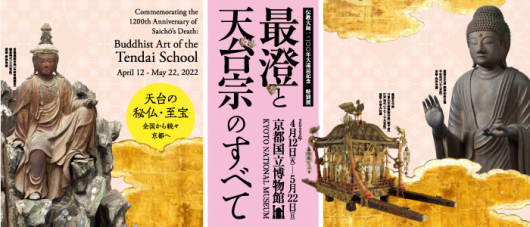Event
Date:April 12–May 22, 2022
The exhibition has two installations:
Part I: April 12–May 1, 2022
Part II: May 3–22, 2022
Hours:
9:30 a.m.-5:00 p.m. (Entrance Until 4:30 p.m.)
Closed:Mondays
Admission:
Adult 1,800 yen (1,600 yen)
Univ. Student 1,200 yen (1,000 yen)
High School Student 700 yen (500 yen)
• Fees in parentheses are advance purchase tickets (available February 18–April 11, 2022). Please see the Special Exhibition Official Website.
• Admission is free for junior high school students and other youths age 0–15, visitors with disabilities and one caretaker. Please show I.D.
• Please show student I.D. for student admission.
• Admission is reduced by 500 yen for Campus Members (including faculty) able to produce I.D.
https://www.kyohaku.go.jp/eng/special/index.html
Venue
Kyoto National Museum Heisei Chishinkan Wing
https://www.kyohaku.go.jp/eng/index.html
Access:527 Chaya-cho, Higashiyama-ku,
Kyoto, Japan 605-0931
Overview
2021 marks the 1200th anniversary of the death of Dengyō Daishi Saichō (767–822), founder of Japan’s Tendai school of Buddhism. Saichō was moved by the Lotus Sutra’s egalitarian teaching that “the path to enlightenment is open for anybody,” a doctrine that formed the basis of Tendai Buddhism’s propagation across Japan. Saichō established Enryaku-ji Temple on Mount Hiei, an area overlooking Lake Biwa to the east and Kyoto to the west. The temple produced many eminent priests whose diverse teachings would have a major impact on Japanese culture. On this occasion, the special exhibition Buddhist Art of the Tendai School will be held at the Tokyo National Museum, the Kyushu National Museum, and the Kyoto National Museum over three periods between October 2021 and May 2022. The exhibition traces the history of the Tendai school in Japan, from its founding at Enryaku-ji Temple to the construction of Tōeizan Kan’ei-ji Temple and the establishment of strong ties with the shogunal government during the Edo period (1603–1868). While taking advantage of the regional characteristics of each venue, the exhibition will present treasures passed down throughout Japan and cultural properties that exemplify the concept of universal salvation expressed in the Lotus Sutra.






